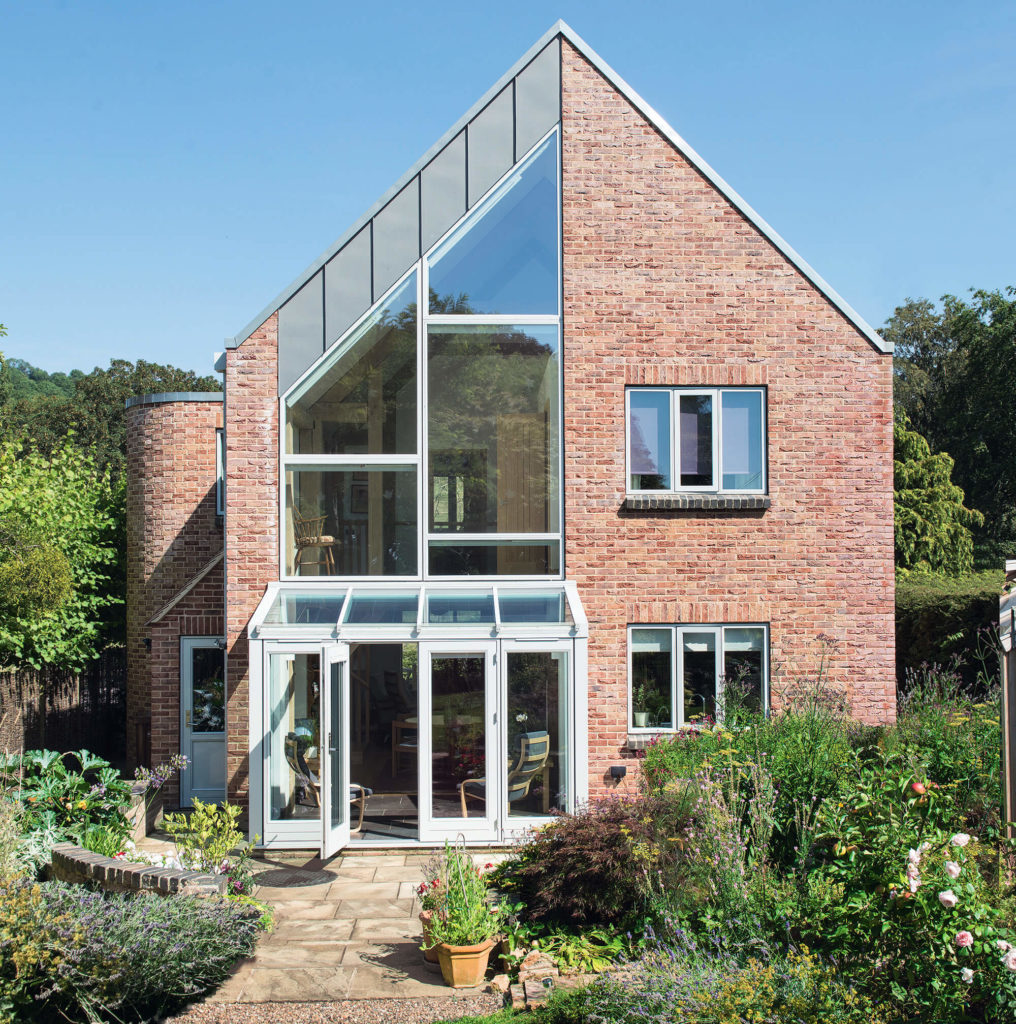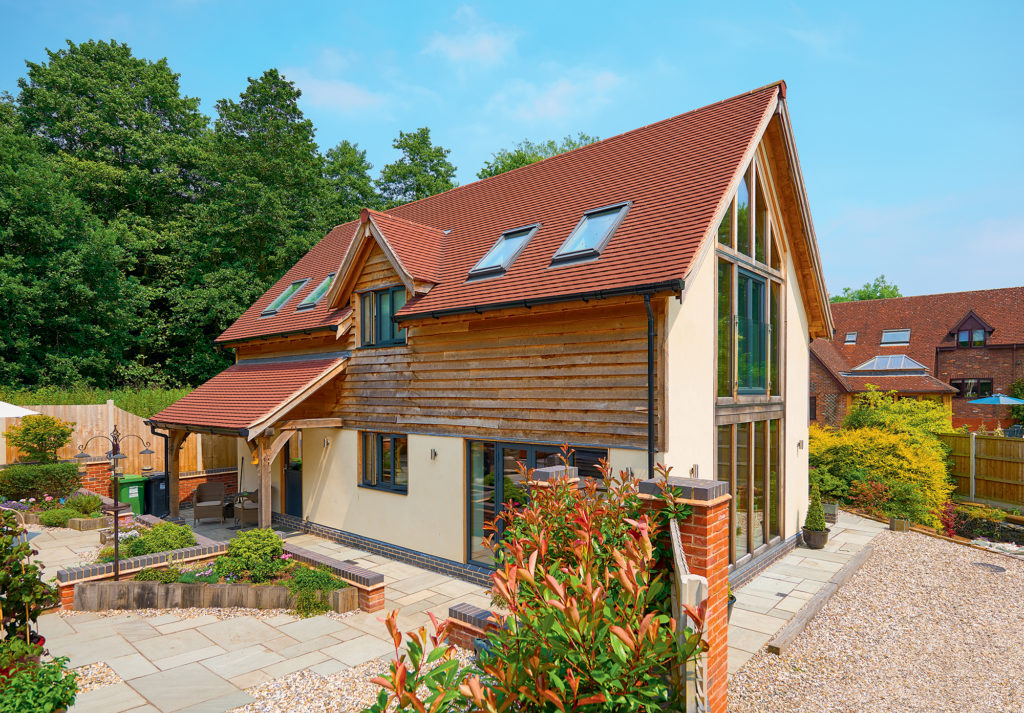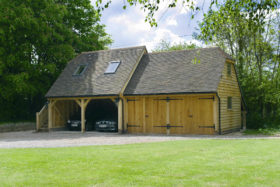
9th & 10th September, Westpoint Arena, Exeter. 100s of suppliers, seminars, expert advice. Explore all the options, all in one place – only at Build It Live.
Book your free tickets now
9th & 10th September, Westpoint Arena, Exeter. 100s of suppliers, seminars, expert advice. Explore all the options, all in one place – only at Build It Live.
Book your free tickets nowOak frame has been popular in construction for centuries. Oak’s sustainability, sturdiness and durability make it an excellent choice for the environmentally conscious. What’s more, many simply fall in love with the charming character offered by this hardwood as it dries.
What’s more, manufacturers continue to enhance this method’s inherent benefits to suit modern self-builders’ needs. Today’s oak homes offer high insulation standards, impressive airtightness and innovative architecture alongside their innate aesthetic appeal.
If sourced responsibly, oak can be a sustainable material. Look for PEFC and FSC certifications to ensure you’re buying from environmentally managed forests.
Embodied energy (the resources consumed by all of the processes associated with the production of the building) is also relatively low compared to some systems. Plus, oak frame homes can last for hundreds of years.
For entire dwellings you’ll be using green oak. Green oak is wood that’s been felled in the last 18 months and has a moisture content of around 80%. This is cheaper and easier to cut and shape than air or kiln dried wood.

This new home combines an oak frame with structural insulated panels (SIPs). The brick, glass and metal finish creates a striking contemporary look
One of the challenges for oak frame has been achieving a highly insulated, airtight structural shell, while still preserving the character of the timber.
The solution is to combine traditional and modern techniques by wrapping the oak frame in a insulating encapsulation system. This is usually done with timber frame or structural insulated panels (SIPs). But it is possible to use masonry and even products such as insulating concrete formwork (ICF) or natural straw bale.
Combining the method with SIPs has become very popular in recent years. SIPs panels consist of two layers of oriented strandboard (OSB) bonded around an inner core of insulating material. They are manufactured in a factory, cutting down on building time and labour on site. The controlled environment means they’re finished to excellent specifications.
Some oak frame specialists supply their own proprietary wraparound panels using alternative materials, such as natural insulation. These options can provide equally impressive performance.
Oak Frame Home Case StudyLyn Bullock had a very specific vision for her project: she wanted a flexible home where she could work as a private caterer and chef, while slowly winding down into retirement. The solution was to self build a characterful property from scratch, designed to suit her lifestyle. It would need to be light, efficient, adaptable and low-maintenance. |
“An appropriately designed and manufactured walling and roofing system will ensure the dwelling achieves good airtightness,” says David Grey from Oakwrights. The company recently completed the UK’s first oak frame Passivhaus (a standard requiring exceptional levels of insulation and airtightness).
“The oak structural frame will shrink and move during the natural drying process,” says David. “So allowing the frame to settle independently from the insulated wall and roofing system maintains the performance of the building on an ongoing basis.”
The quality of craftsmanship will play a crucial role when it comes to maximising the energy efficiency of your new home. “Airtightness is achieved through a combination of good design, appropriate materials and excellent construction detailing methods,” says Merry Albright from Border Oak.
“The most important thing is to educate the team on site, as even the most airtight building envelope can be ruined by a misplaced pipe hole or bad taping.”
A wide range of internal layouts is possible thanks to the sizeable beams – you can specify trusses up to 10m for domestic purposes – as well as the incorporation of steel in some designs. So you can create both small and large open-plan spaces. Bear in mind, though, that very large rooms will need intermediate posts to support the spans.

The Spillanes’ self build home features large expanses of glass and a blue zinc roof. The oak frame, crafted and erected by Carpenter Oak, is supported on steel posts, adding an industrial touch
More Projects from Carpenter Oak
One of the characteristics of oak frame homes is the shrinking and splitting of the timber as it dries out. These do not constitute a structural issue. However, your designer will have to take the wood’s behaviour into account, especially when incorporating glass in the design.
Good architectural detailing at the planning stages, followed by proper execution on site, are key to successfully incorporating large areas of glazing into an oak frame scheme.
So make sure you work with a specialist team that understands shrinkage in oak and has a proven track record of success. New techniques exist that mitigate against shrinkage, as well as accommodating other potential movement as the oak dries, such as twisting and splitting.
One of the most popular solutions is to fit sealed units on to the face of the posts and beams, as opposed to installing the glass panels in the frame itself.
“The secret to introducing glazing to your design is to have a flexible joint between the structural oak and the glass,” says David. This, coupled with flexible weather seal joints, allows the structure to move independently.
“The appearance of the frame externally is then achieved by using oak capping on the outside of the glass panels,” says Kat Hamilton from Oakmasters. “This way, the glazing and envelope stay watertight.”

This oak frame home has been installed with swathes of full height glazing to add contemporary appeal
Another modern solution that has noticeably updated the look of oak frame dwellings is the incorporation of stainless steel. Pairing these two elements brings an industrial feel to the home when the metal is left exposed.
It also allows for further versatility in the design. Incorporating steel joints and beams can help to enable larger spaces and architectural options, such as cantilevers and wider spaces of full-height glazing.
Glulam beams (glue-laminated wood) are a modern alternative to oak beams and steel joists. The product’s laminated makeup and low moisture content of around 12% mean it won’t shrink or twist as green oak does.
Glulam can span great distances, which opens up new design possibilities. Its stability also means decorative finishes can be applied more easily, as the structure won’t move – or split – over time as much as green oak does.
Building with oak can be a great deal faster than with other traditional methods. Once you have your design, the frame is fabricated in the workshop while works such as clearing the plot and laying foundations start on site.
Once the oak skeleton is delivered, it can be erected in just a few days thanks to the use of cranes, significantly cutting down overall build time. “And if you are wrapping with SIPs, then you can reach watertight stage even faster,” says Vicci Lewis, designer at Oakmasters.
Is oak frame a fire risk?
|
Most self-builders choose a flat-planed finish. This makes the wood soft to the touch (no splinters) and evens out saw marks from the felling and conversion procedures.
Your oak frame will have to be cleaned after the building is completed, to erase any unwanted marks from the construction process – such as dust, mud etc. The main options are an oxalic acid treatment, which gives the timber a clean look, or sand blasting for a rougher, more rustic feel.
“Oak frames don’t need any form of treatment to keep their structural integrity,” says David. “European oak, which is used the most by manufacturers, is naturally durable. So any finish that is applied is for aesthetic purposes only.”
Modern oak frames can be covered in an extensive variety of finishes. “Any cladding can be applied to the outside of the insulated walling and roofing system,” says David.
Which one you choose will come down to your personal preferences, what suits the surroundings and any conditions in your planning permission. A popular trend is to pair up the high-performance frame with materials such as handmade bricks, natural stone or timber cladding.
The overarching style of vernacular architecture in your area may dictate your choice of cladding and roofing materials. For instance, oak homes often feature a stone finish in the Cotswolds, or tile hanging in areas such as Kent.
“Render and weatherboard are very popular for contemporary designs, with most new builds having a mix of materials alongside extensive glazing,” adds Merry. “That is the beauty of oak framing. It is versatile and organic and offers a tremendous creative range.”
Main image: Border Oak

